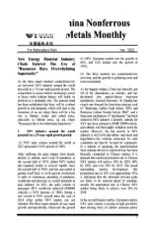The Way out for the Aluminum Industry May Lies in Vertical Integration
2013-08-15
On January 22, the merger and reorganization of nine major industries, a project propelled by the Ministry of Industry and Information Technology, the National Development and Reform Commission, and the State-owned Assets Supervision and Administration Commission formally kicked off, which includes electrolytic aluminum industry. The above ministries and commissions proposed to develop a number of electrolytic aluminum enterprise groups with core competitiveness and international influence by 2015, the percentage of top ten enterprises’ smelting capacity in national total will reach 90%, develop 3~5 large enterprise groups with strong international competitiveness. Previously it has also unveiled policies to promote electrolytic aluminum industry association between strong enterprises and cross-regional M&A, but this industry has “very few M&A”in recent years.
Driven by economic benefits in the recent several years, the electrolytic aluminum industry expanded so rapidly as to lead to serious surplus capacity. Nationwide electrolytic aluminum production capacity has surpassed 27 million tonnes, but even if today some new projects are still being launched in some western provinces in China. The production capacity is constantly expanding; industry concentra-tion degree has not been effectively increased.Chalco’s capacity percentage is around 15%,the capacity percentage of other large enterprises such as China Power Investment is even less, “There are currently more than 100 electrolytic aluminum factories nationwide, despite the presence of large electrolytic aluminum factories, they lag far behind the 90% capacity percentage standard.” In fact, to solve the problem of low concentration degree in electrolytic aluminum industry, this is not the first time that relevant ministries and commissions put forward related guidance policies. As early as in 2009, the National Development and Reform Commission demanded to restrain capacity surplus and repeated construction in iron&steel,cement, and polycrystalline silicon industries;in 2010, the “Opinions of the State Council on Promoting Enterprise M&A” was promulgated,which demanded to focus on electrolytic aluminum industries to promote advantageous enterprises to implement association between strong enterprises, cross-regional M&A, overseas acquisition and investment cooperation;the Ministry of Industry and Information Technology subsequently promulgated “Notice on Further Strengthening Enterprise M&A Work”to further boost M&A.
Compared with enterprise integration campaign in other industries including the iron&steel industry in recent years, the electrolytic aluminum industry remained in stable condition, enterprises rarely made substantial progress in M&A aspect. “Despite the policies in past years, in the recent two years there were very few M&A cases between aluminum enterprises.” According to Xu Hongping, analyst of Xinhu Futures; according to available info, the reason that the electrolytic aluminum industry had very few cross-province and cross-regional integrations can be attributed to industry features: Aluminum industry is obviously restrained by raw materials, generally when an enterprise is developing locally, it must have advantages in resource aspect, but in crossprovince cooperation the other side may not give generous terms, compared with scale benefit in other industries, aluminum industry more highlight refined management. Furthermore,aluminum industry is a high energy consuming industry, as a result the electrolytic aluminum has to confront pressure in energy saving and emission reduction work nearly every year,therefore it is not a key project that local governments intend to introduce. “Either from the perspective of environmental protection or project prospects, it is not a good option for local governments.” said Xu Hongping.
For more aluminum enterprises especially those in East China, their current usual practice is to shut down local old factories, and transfer personnel and equipment to regions with superior energy advantages such as Xinjiang. It has been learned that preciously electrolytic aluminum capacity expansion was very fast in Shandong Province and Henan Province, the capacity nearly doubled, but later these projects suspended construction, and were transferred to the West. Xu Hongping was of the opinion that in the electrolytic aluminum industry, even M&A is implemented in the future, there is a great likelihood of vertical development, for instance an electrolytic aluminum enterprise merges an aluminum oxide enterprise, whereas the possibility of lateral integration is very small. “It’s not prudent for one electrolytic aluminum enterprise to merge another one, because the acquisition may turn out to lose money”. One obvious example is that in the previous month, Shanxi Yagnquan Aluminum Industrial Co., Ltd, a company with 30 plus years of history, suspended production due to insolvency. Because it has no self owned power plant, there is also a lack of raw materials; even if the local state-owned assets supervision and administration commissions took the initiative to promote restructuring work, no suitable buyers will come forward. “If such enterprises are sold, without asset injection by enterprises with substantial strength, such deal is equivalent to buying a pile of scrap metal.” said Xu Hongping, who has just finished relevant survey. Xu Hongping also considered that industry concentration degree should not have only size requirement, “many enterprises only focus on expanding scale, but they have poor cost trans-fer ability, resulting in weak profit-earning ability despite its big size”. Before the global financial crisis, Chalco had acquired some enterprises, but most of these newly acquired enterprises were generally losing money, “some of them are old factories, with backward equipment, the acquisition cost was even higher than newly built project”.
杂志排行
China Nonferrous Metals Monthly的其它文章
- Railway Investment Scale Upgraded to Directly Benefit Copper Wires &Cables and Alloys
- Xinjiang Nickel Production Topped 10,000 tonnes, with the Potential to Become the Second Largest Production Base in China
- Loss of Balance between Tungsten Reserve and Mining,China’s Resource Advantage Is Weakening
- The Ministry of Land and Resources Continued to Impose Total Exploitation Control on Tungsten, Antimony andRare Earth
- In 2012 Qinghai Newly Discovered 2.36 Million Tonnes of Copper, Lead and Zinc and 440,000 tonnes of Nickel in 14 ore fields
- Domestic aluminum enterprises“stored electricity” in winter for the sake of self rescue
